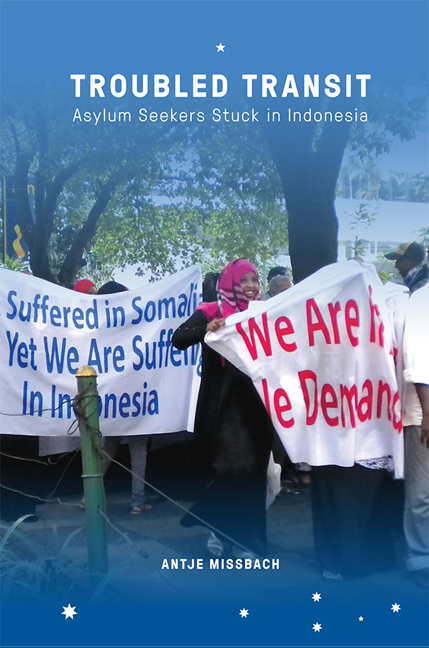Book contents
- Frontmatter
- Contents
- List of tables
- Acknowledgements
- Map of Indonesia
- Acronyms and Initialisms
- 1 Introduction
- 2 Transiting Indonesia: Past and Present
- 3 The Politics of Detention
- 4 Life on Hold
- 5 The Limits of Protection
- 6 Indonesia as a Transit State: Obligations, Policies, and Practice
- 7 Tidal Ebb and Flow: The Indonesia-Australia Relationship
- 8 Selling Hope
- 9 Conclusion
- Bibliography
- Index
- About the Author
7 - Tidal Ebb and Flow: The Indonesia-Australia Relationship
Published online by Cambridge University Press: 19 May 2017
- Frontmatter
- Contents
- List of tables
- Acknowledgements
- Map of Indonesia
- Acronyms and Initialisms
- 1 Introduction
- 2 Transiting Indonesia: Past and Present
- 3 The Politics of Detention
- 4 Life on Hold
- 5 The Limits of Protection
- 6 Indonesia as a Transit State: Obligations, Policies, and Practice
- 7 Tidal Ebb and Flow: The Indonesia-Australia Relationship
- 8 Selling Hope
- 9 Conclusion
- Bibliography
- Index
- About the Author
Summary
The Indonesian government needs to be wary of Australia's measures
and policies, which are turning Indonesia into a fortress that
fences off refugees and asylum seekers so that they cannot get to
Australia. Eventually, Indonesia itself will be “flooded” with
refugees and asylum seekers.
(Komnas HAM 2012, p. 10)
Relations between Indonesia and Australia are often marked by extreme ups and downs (Brown 2013; Bhakti 2013). Even though Australia has at times been Indonesia's largest aid donor, rapid changes in political mood and underlying mutual mistrust have affected their relationship during the last fifteen years. The issues that have dominated the political agenda, and at times caused serious misunderstanding, have mostly been connected to Islamic terrorism and threats to Indonesia's sovereignty from both local separatism and irregular migration. Since 2009, when the number of asylum seekers coming to Australia by boat started to increase dramatically, the primary objective of Australian politicians has been to put an end to their movement, using a number of different battle cries, such as “stopping the people-smuggler business model” and just “stopping the boats”, which ignore the plight of the people in “the boats”.
Aware that stopping the movement of asylum seekers could not be achieved without the support of Indonesia, Australian politicians tried hard to win concessions from Indonesia by offering substantial incentives, while exerting constant political pressure but often ignoring issues that were important to successive Indonesian governments. As Meidyatama Suryodiningrat, the Jakarta Post's editor-in-chief, noted during a TV panel discussion in July 2013, Australia should not have “unreasonable expectations” when it comes to dealing with irregular migration, given that Indonesia faces many more serious problems with the regular and irregular labour migration of its national workforce and the frequent abuse of labour migrants, especially in Malaysia and Saudi Arabia. Although Indonesia agreed to join Australia-driven anti-people-smuggling initiatives, extended its border control and detention facilities for irregular travellers, and changed laws regulating immigration issues (as outlined in Chapter 6), it has at times complied only reluctantly with Australia's requests. Australia's continuing failure to acknowledge Indonesia's priorities and its repeated overstepping of the boundaries of its authority have caused extreme frustration in Indonesian government circles.
- Type
- Chapter
- Information
- Troubled TransitAsylum Seekers Stuck in Indonesia, pp. 177 - 208Publisher: ISEAS–Yusof Ishak InstitutePrint publication year: 2015

